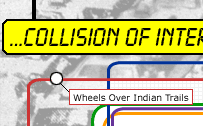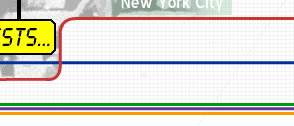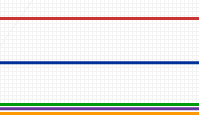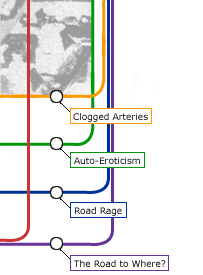



Situationist Theses on Traffic || The Social Ideology of the Motorcar || Killed by Automobile || Excess
How Traffic Destroys the Eco-City
by David Engwicht
Fear of Crime
It is fairly well accepted that people who feel alienated from their society are more likely to take out their frustration on society by some violent act. But what is not equally recognized is that one of the major causes of that alienation, loss of the road and pavement as exchange space, also increases the opportunity for crime.
One of the greatest deterrents to would-be criminals are curious eyes. Rapists and muggers usually choose dark parks, car parks or deserted streets as the scene of their attacks, far from prying eyes. Vibrant neighborhoods where the streets are alive with people and people are watching the street- life from their gardens and windows, are places which are inherently safer than deserted streets where curtains are drawn. Here, again, it is easy to see how these feedback cycles feed on themselves. Once there have been one or two muggings, thefts, or rapes in these deserted streets, fear begins to rule, further diminishing the attractiveness of the street for people and thus making it more unsafe.
One reaction when fear rules the streets is to take refuge in vehicles. As Jane Jacobs says, 'This is the technique practiced in the big wild-animal reservations in Africa, where tourists are warned not to leave their cars under no circumstances until they reach the lodge. It is also the technique practiced in Los Angeles'. With a rate for rape twice that on any other city, is it any wonder that the people of Los Angeles feel they must take refuge in their cars? In Donald Appleyard's study, the fear of crime was almost three times higher on Heavy street as on Light street. People had not abandoned the street just because of the traffic.
There is an incredible sense of fear that settles on Los Angeles as soon as it is dark. At night I felt totally afraid even though the wail of police sirens could be heard and police cars seemed to be everywhere. If anyone came within fifty meters I would start running.
The contrast with the friendliness and sense of community in most European cities was striking. For example, I arrived in Hamburg at night and asked a man if he could show me on a map where I was. He did not speak English, but a women walking past overheard and asked if she could help. She spoke only broken English and I asked if she could point out where I was. Instead, she asked where I wanted to go. I explained I wanted to walk to the Youth Hostel. She insisted on walking with me and showing me the way. One and a half hours later, well after 9:30 p.m., she delivered me right to the door of the hostel. On the way she had taken me on a guided tour of the city explaining all the highlights. At no time did I feel afraid.
What Appleyard discovered in microcosm, I saw transferred to whole cities. In Los Angeles the streets had been abandoned. Alienation ruled by day and fear by night. In cities where higher priority was placed on public transport, bikes and walking, the streets were alive with human activities and a sense of neighborliness ruled. They could even leave their chairs in the city square! As Bertrand Le Gendre wrote, 'Violence in towns is first of all the violence which has been done to the towns themselves. Theft is encouraged by the feeling that nothing belongs to anyone, at least not to anyone who can be identified'.
Atomisation of Society
There is an ironic twist to this whole scenario of traffic eroding the level of social interaction in a community. More and more demand is placed on the individual members of a family to meet each other's entire range of social, emotional and spiritual needs. Many relationships cannot stand this unnatural demand and crack under the strain, in some cases fracturing the most important of all human relationships. While I would not go so far as to blame the automobile for the incredible increase in family breakdown, it is nonetheless a very important element in understanding the atomisation of society and the result plague of alienation.
The feedback cycle, in this case, is that as the basic unit of society has shrunk from the tribe to the one- or two-person family, increasing demand has been placed on support systems outside the home or neighborhood to meet those needs that were once met internally.
The Nuremburg Experience
I related earlier how my experience of the main street of Nuremburg led me to an understanding of the concept of spontaneous exchange. As I reflected on this idea a fairly radical concept began to form. I asked myself how the people of Nuremburg would replace the wide range of spontaneous exchange opportunities being enjoyed in the street, if the 30,000 vehicles were allowed back into the street again. It suddenly dawned on me that it was possible to travel more yet end up with less exchange.
This was the idea I began developing for the 1991 International Transport Conference. I showed an earlier draft of my paper to Bill Croft, a lateral-thinking engineer who was heading up a passenger transport review for South- East Queensland. He was excited by the possibilities but told me that if engineers were to grasp the concept they would need some graphs. On the white board of his office he drew the graph shown in fig. 7. It was a stroke of genius because it helps explain the concept that while movement (travel) is necessary to facilitate some exchange, it simultaneously erodes exchange. There are four stages of this process.
Stage One: Rapid Growth in Exchange Opportunities
Initial provisions for travel produce a net increase in exchanges because traffic levels are not yet at a sufficient level to greatly diminish spontaneous exchange or demand that exchange space be converted to movement space.
Stage Two: Decreasing Rate of Return
As traffic increases it erodes greater amounts of spontaneous exchange and the city spreads as increasing amounts of space are dedicated to movement infrastructure. The feedback cycles outlined above result in decreasing rates of return. In other words, the travel is not as productive as it was in Stage One because the gains are being eroded by the feedback cycles. In Stage One, doubling movement doubled exchange opportunities. In Stage Two, doubling movement may only give 30 percent increase in exchange opportunities.
Stage Three: Equilibrium
In Stage Three equilibrium is reached. In other words, any further gains in exchange are cancelled by losses incurred because of the numerous feedback loops discussed earlier.
Stage Four: Getting Less for More
In stage four the feedback cycles set up by an attempt to increase movement are not only self-canceling (Stage Three) but begin to eat into the previous gains in exchange opportunities; in other words, getting less exchange for more travel. Unfortunately this is the stage which our car- dominated cities have reached. This is the stage where people destroy their destinations in going to them. It is a bit like breaking up your house and burning it in the fireplace to stay warm. Eventually you are left out in the cold which no house and no fire.
The logical conclusion from understanding this process is that the cities that have entered Stage Three or Four could offer their citizens higher levels of exchange for less travelling by reducing road infrastructure and turning it back into exchange space.
Some people will protest that surely people have access to a wider range of facilities opened up by the car. This is true taking a short-term view. If I was a pedestrian yesterday and a motorist today, then there is no argument that I have greater mobility today than I had yesterday. But what is being explored here are not the short-term consequences of one person's choice, but the medium to long- term consequences of collective choices. Talk to those who remember the city before the car took over, or visit Los Angeles and then Nuremburg and it will be seen that the Exchange Efficiency Curve is no fantasy. We are going backwards.
Getting More with Less
Some forms of transport are more 'exchange friendly' than others. In other words, some forms of transportation are more savage in their erosion of spontaneous exchange and have a more ferocious appetite for space; they therefore produce stronger feedback effects. Walking, cycling and public transport facilitate spontaneous exchange rather than destroy it and are more space- efficient than cars, so it is possible to increase movement without making the same demands for exchange space to be converted into movement space. Nor do they contribute to the cycles of fear of crime like cars. Thus cities which rely on exchange- friendly forms of transport will have much higher returns of exchange opportunities for the same amount of movement because the feedback effects do not undermine the gains to the same extent.
A Nudge is as Good as a Wink
In Chaos-Making a New Science, James Gleick tells how Edward Lorenz, in 1961, stumbled upon a discovery that was the beginning of a whole new science. As a child Lorenz was fascinated by mathematical puzzles and after graduating from Dartmouth College in 1938 he was convinced that mathematics was his calling. But World War II intervened and he found himself in the Army Air Corps working as a weather forecaster. After the war he decided to combined his two interests and apply his mathematics to meteorology. Along with all Western scientists, Lorenz believed in the Newtonian promise of a deterministic world in which one could tell with absolute surety how the world would unfold, providing you understood the rules.
Lorenz also accepted another fundamental tenet of Western science which one theoretician put as following:
The basic idea Western science is that you don't have to take into account the falling of a leaf on some planet in another galaxy when you're trying to account for the for the motion of a billiard ball on a pool table on earth. Very small influences can be neglected. There's a convergence in the way things work, and arbitrarily small influences do not blow up to have arbitrarily large effects.
What concerned Lorenz was the large weather picture. Surely global weather patterns could be predicted if one had the time to do the myriad of calculations needed? In 1960 Lorenz obtained the means in the form of a noisy, bulky Royal McBee computer. Lorenz decided to build a simplified version of world weather patterns using just 12 of the variables that affected weather. It was a toy world. Gleick takes up the story:
He was the God of this machine universe, free to choose the laws of nature as he pleased. After a certain amount of undivine trial and error, he chose 12. They were numerical rules -- equations that expressed the relationships between temperature and pressure, between pressure and wind speed. Lorenz understood that he was putting into practice the laws of Newton, appropriate tools of a clockmaker deity who could create a world and set it running for eternity.
Lorenz's toy weather world fascinated his colleagues. Punch in a set of 12 conditions and every minute the computer would print out a list of figures that for the initiated told the story of weather for that day; winds shifting from north to south, digitized cyclones whirling across the page. Colleagues and graduate students would gather round and lay bets on what Lorenz's toy weather world would do next.
Lorenz created a primitive way of printing out graphs for each of the 12 variables. One day in the winter of 1961 he decided to examine one of these graph sequences in greater detail. Instead of re-running the whole program from the beginning he decided to start in the middle by typing in the appropriate figures for the 12 conditions as indicated on a printout for the day which he wanted to start. Setting the computer going he went down the hall to make a cup of coffee and get away from the noisy machine. When he returned something had gone drastically wrong.
The forecasted weather should have been the same for both computer runs. Exactly the same preconditions had been entered and he had not changed the rules of his toy universe. But as Lorenz stared at the new printout the weather bore no resemblance to what had been predicted in the computer run the day before. In fact, for some days the predictions were exactly opposites. He was bewildered. What could have gone wrong? Was it a faulty vacuum tube? Suddenly the reason dawned. His computer made calculations to six decimal points. But his printout was only to three decimal points. So while the computer had stored 0.506127 it had printed out 0.506.
But why should this make such a huge difference? It represents a change of just one part of ten thousand. It was almost impossible for meteorologists even to measure this much difference in, say, the temperature of the ocean. Lorenz has assumed that given a certain starting point the weather would always unfold the same way. If you changed the starting point slightly, the outcome would change slightly. His one part in a thousand error was like a small puff of wind. Surely these small puffs of wind just dissipated or were cancelled by some other one-part-in-a-thousand puff of wind? Yet Lorenz's computer had just told him that a small puff of wind could change the weather pattern over the whole globe within two months.
In the next few days Lorenz set out to confirm his accidental finding that small changes could produce catastrophic changes. Changing just one small input he would overlay the results. Always it was the same, wide divergence in a very short time. For Lorenz, long range forecasting was doomed. What Lorenz discovered became known as the Butterfly Effect: a butterfly's wing flap in China may be the cause of a hurricane in Florida a week later.
Planners are only beginning to ask what the implications of chaos may be for their traffic and population long range computer forecasting. Could knocking down one corner store to widen an intersection be the flap of a butterfly's wing that puts the whole city's transport into chaos? One of the few who have seen the link and started applying the insights of chaos to city planning is T. Cartwright. He says:
Gathering more information or constructing more elaborate models about chaotic systems can become pointless. In fact 'research' can be even be counter-productive, if it creates a false sense of security about planning and what it can do. Our ability to predict the behavior of chaotic systems is inherently limited... Looking for more accurate models of housing demand or traffic flow [is] potentially a fool's errand if these phenomena are indeed chaotic.
Cartwright is feeling his way. He is not sure whether the city is a chaotic system or not; or when it may become chaotic. He confuses himself because he begins by examining how chaos arises in a system with two variables that interact; in his study, a population which grows at a fixed rate (births over natural dearth) and the limitations imposed by the environment on total population (overcrowding, disease, food shortages, losses to predators, etc.). By applying some simple mathematical formulae, Cartwright found what chaos scientists have found for all two element systems (for example a flame heating a pot of water); the system goes through three distinct stages depending on the initial settings of the two variables. These stages are: stable equilibrium -- either extinction or a stable population; dynamic equilibrium -- predictable cycles of boom and bust; and chaos- unpredictable but with 'islands' of order.
But like weather, the city is not a two element or even a 12 element system. There are a myriad of variables that influence traffic and population levels. By far the most important consideration, and the one that automatically makes both the weather and cities chaotic, is the element of self-determination. The butterfly has the power of choice, and exercise of its free will to flap its wings at a crucial moment in a crucial place may change the entire weather of the planet in just two months. Similarly, one person deciding to knock down one shop to widen one intersection may change the city's entire traffic system within a very short time; I suspect as little as two to five years.
It seems impossible until you see how it works in reality. For example, the council recently decided to widen the road through our local shopping center. When I complained to the person responsible for the decision I was told it was only a minor piece of work that would have no impact. I explained that it would dispossess ten local businesses. He replied that he had surveyed the area and found that there were enough vacant shops for them all to relocate locally. I told him this was na•ve in the extreme. I continued:
The vacant shops are all in a new, up-market development where rents are three to ten times higher. Surely you understand that a shopping center needs a mix of old and new shops? Businesses that are marginal need the older shops were rents are lower. Force these into a higher rent situation and in six to 12 months they will be out of business. This will immediately affect the viability of all the other shop owners. For example, one of the shops is a specialist bed shop. There are no other premises big enough so the owners intend closing permanently. At the moment this shop attracts people in the market for a bed from the whole region, and while in Ashgrove these people may but a pie, a drink, get their hair cut, or lay-by a dress. Those people won't come now. In the end other businesses will become marginal and close down, taking others with them.When the shopping center eventually runs down, people will be forced to drive to a regional shopping center. The new traffic will demand that roads through other shopping centers be widened and so the cancerous process will start all over again in someone else's neighborhood. Minor works indeed, but city-wide implications.
This is the process of urban blight; the creation of one cancerous cell that infects others and destroys an entire neighborhood and eventually an entire city.
The late Father Graham Perry told the following story in CART's very first community newspaper:
When I first came to Brisbane, I obtained an apprenticeship in Annerley. After a great deal of searching I found accommodation in an old boarding house. Nothing fancy, but comfortable. But my stay was short-lived because the City Council wanted to widen Ipswich Road to take more traffic. So I moved to another place by the tram depot opposite the PA hospital. It was a relatively quiet, friendly community. People cared for each other and were proud of their area. I attended the Thompson Estate Anglican Church which was packed with friendly people. This church typified the many other vibrant community groups in the district. But all this changed. The tranquil suburb of Annerley has been shattered by the South Eastern Freeway, soaring thirty feet above the rooftops. Going back to the suburb you now find a split community... Empty shops... Empty churches. A suburb without a soul.
Marshall Berman calls this process of urban blight 'urbicide: murder of a city'. In a stirring article in the New Internationalist, Berman described how urban blight destroyed the once proud neighborhood of his childhood in New York.
The South Bronx, where I spent my childhood and my youth, is the site of one of the greatest recent ruins today outside Beirut. The physical and social destruction of the area began with the construction of the Cross Bronx Expressway in the late 1950's and early 1960's spreading gradually southward from the highway and northward from the emerging Bruckner Expressway in the late sixties.Then in the early 1970's the disintegration began to spread at a spectacular pace, devouring house after house and block after block, displacing thousands of people like some inexorable plague. Those were the years when the Bronx finally made it into the media, as a symbol of every disaster that could happen to a city. 'The Bronx is burning!' resonated all over the world...
Every time I saw or heard about another landmark (streets I'd played in, houses were friends lived; schools, shops synagogues) I felt a piece of my flesh was being ripped away...
In our sense of loss and violation we have plenty of company. In the South Bronx alone, more than 30,000 people fled in the 1970s as their homes were being destroyed. Many of these people were forced to run more than once, trying to stay ahead of the blight that kept catching up with them. Thousands more in Manhattan and in Brooklyn went through the same ordeal. In fact something similar was happening in working-class neighborhoods in older cities all over the US...
While both these examples are dramatic in that they are not the gentle nudge of a butterfly's wing but the mad hacking of a meat axe, they nevertheless concentrate into a snapshot the possible long-term effects of the gentle nudge (or wink to a developer or road builder).
But while the scientist of chaos may be frightened with the long-term implications of a nudge or a wink, it also holds incredible promise. The solutions to our traffic problems may not demand the draconian, sledgehammer measures we fear. If a nudge and a wink is enough to lead us into a mess, a nudge and a wink may be all that is needed to pull us out. The future art of city building is knowing the critical time and the critical place to flutter the wings.
Back to top